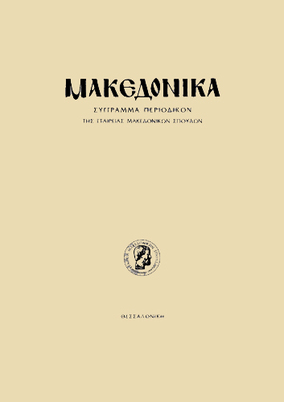Η "εμπράγματη ασφάλεια" σε ολυνθιακές επιγραφές του 4ου π.Χ. αιώνα
Part of : Μακεδονικά ; Vol.30, 1996, pages 67-80
Issue:
Pages:
67-80
Parallel Title:
Real Surety in Macedonian Inscriptions of the Fourth Century B.C
Section Title:
Articles
Author:
Abstract:
Among the Olynthian inscriptions recording the sale and purchase of property, there are four, dating to the mid-fourth century BC, which are rather different in content. Two of the texts concern the contracting of a loan, with real estate mortgaged as surety: in the one case, in which the term of repayment is specified as three years, the mortgage comprises all the debtor’s landed property; in the other, the mortgage consists in the real estate of both debtors (brothers), with the specific exception of certain properties and rooms in the home. The third inscription concerns a sale of property with right of repurchase (πράσις επί λύσει), the contractual term of repayment/repurchase by the seller being set at one year. The fourth text is a legal transaction between two individuals concerning a property (οικία) for the sum of 900 drachmas, with the addition of a period of five years and four months, which may be a repayment term or a term of duration. The contract involves one certifier and three witnesses. The meaning of the verb καθίεται, which is used with reference to the legal transaction, is unclear, for it is not used in this way in any of the sources. It does not seem to be a passage of title, but the establishment of some other real right, either a principal right, such as usufruct or personal servitude, or an incidental right, such as a form of real surety. An inscription of the same period from Amphipolis records a transfer of property (with the original right of repurchase) to a third party, under the same terms as the present seller had bought it; namely, the original owner retained the right to repurchase the property, with no limitation of time. Interestingly, the property is referred to as belonging to the original owner, even though· it is the buyer who is making the sale. An inscription from Vrasta, Halkidiki, concerns the (re)purchase of property for which a mortgage had been given in the past by the brother of the person now making the repurchase. The sale and purchase of landed property with real surety was also practised elsewhere in Greece, including Tenos, Athens, and Amorgos. The literary and epigraphical evidence does not accord with the classic theoretical distinction between πράσις έπί λύσει, ένέχυρον, and υποθήκη, but rather strengthens E. M. Harris’s hypothesis that variations in the terminology used do not denote different types of real surety. This is supported by: i) the fact that one piece of property carries mortgages and a repurchase agreement simultaneously, and so the question arises of who owns the property in question; ii) the confusion in the sources regarding the use of the terminology —the terms denoting υποθήκη and πράσις έπί λύσει are both used in one and the same legal transaction; iii) the identification in the sources of the buyer with the mortgage creditor, with regard to the manner of the property’s acquisition.These, at first sight conflicting, data suggest that the right in question is not full ownership, but only one aspect of ownership, namely the right to dispose of the mortgaged property. Thus, whoever pays money in principle acquires the right to dispose of the property; but this is identified with full ownership only if no-one retains the right to repurchase it after the term specified in the agreement. However, before the term has expired, as also in cases when no term is specified, the mortgage creditor has, and may pass on, the right to transfer the property, while the debtor retains the claim, proceeding from his contractual right, to regain ownership by paying the price.
Subject:
Subject (LC):
Notes:
856:https://ejournals.epublishing.ekt.gr/index.php/makedonika/article/view/5801, DOI: https://doi.org/10.12681/makedonika.240
Electronic Resources:




